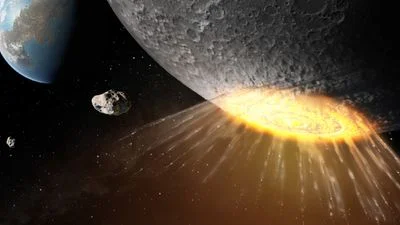
Lunar Magnetic Mystery: Did Asteroid Impacts Magnetize Moon Rocks?
For decades, scientists have been puzzled by a seemingly contradictory phenomenon: moon rocks exhibit strong magnetic signatures, yet the Moon itself lacks a global magnetic field today. This mystery, originating from samples collected during NASA's Apollo missions, has spurred numerous theories. Now, a new study offers a compelling explanation: a colossal asteroid impact billions of years ago may have briefly amplified the Moon's ancient, weak magnetic field, leaving a detectable magnetic imprint on lunar rocks.
Researchers at MIT, led by graduate student Isaac Narrett, propose that a massive impact event, potentially the one that formed the Imbrium Basin, the sea of showers on the moon's nearside, could explain this anomaly. Their computer simulations suggest that the impact vaporized surface material, creating a cloud of superheated, electrically charged particles known as plasma.

As this plasma enveloped the Moon, it concentrated on the opposite side of the impact, temporarily amplifying the magnetic field in that region. The lunar rocks in the area could then have captured this brief magnetic surge before it faded away. The researchers estimate that this entire sequence of events unfolded in less than an hour, yet left a lasting magnetic signature. This hypothesis provides an explanation for the strong magnetic fields measured by orbiting spacecraft, particularly on the far side of the Moon.
Benjamin Weiss, a professor of Earth and planetary sciences at MIT, uses a clever analogy: "It's as if you throw a 52-card deck in the air, in a magnetic field, and each card has a compass needle. When the cards settle back to the ground, they do so in a new orientation — that's essentially the magnetization process." This vividly illustrates how the impact could have realigned the magnetic properties within the rocks.
Other explanations for lunar magnetism have been proposed. Some theories suggest the Moon had a core dynamo in its early history, while others point to meteorite impacts as the source of magnetism. However, the MIT team's research uniquely combines a weak lunar dynamo with the impact plasma shockwave, potentially resolving the conundrum of lunar magnetism.

This theory could be put to the test by future missions. The most strongly magnetized rocks lie near the Moon's south pole, on the far side – an area targeted by NASA's Artemis program and other international missions. If these rocks show signs of both shock and ancient magnetism, it would provide direct evidence supporting the impact hypothesis. As Rona Oran, co-author from MIT notes, this research offers a testable hypothesis.
The puzzle of the magnetized moon rocks persists, but this new research provides a compelling and testable explanation. The study, published in the journal Science Advances, suggests that both a weak lunar dynamo and a cataclysmic asteroid strike are responsible for the magnetic properties we see in lunar rocks today. Future lunar missions have the chance to confirm or deny the findings.
What do you think? Did asteroid impacts play a crucial role in shaping the Moon's magnetic landscape? Share your thoughts and opinions in the comments below!